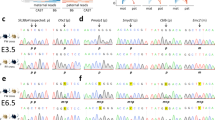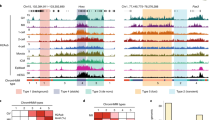Abstract
Imprinted genes are clustered in domains, and their allelic repression is mediated by imprinting control regions1,2,3. These imprinting control regions are marked by DNA methylation, which is essential to maintain imprinting in the embryo4. To explore how imprinting is regulated in placenta, we studied the Kcnq1 domain on mouse distal chromosome 7. This large domain is controlled by an intronic imprinting control region5,6 and comprises multiple genes that are imprinted in placenta, without the involvement of promoter DNA methylation7,8,9,10. We found that the paternal repression along the domain involves acquisition of trimethylation at Lys27 and dimethylation at Lys9 of histone H3. Eed-Ezh2 Polycomb complexes are recruited to the paternal chromosome and potentially regulate its repressive histone methylation. Studies on embryonic stem cells and early embryos support our proposal that chromatin repression is established early in development and is maintained in the placenta. In the embryo, however, imprinting is stably maintained only at genes that have promoter DNA methylation. These data underscore the importance of histone methylation in placental imprinting and identify mechanistic similarities with X-chromosome inactivation in extraembryonic tissues, suggesting that the two epigenetic mechanisms are evolutionarily linked.
This is a preview of subscription content, access via your institution
Access options
Subscribe to this journal
Receive 12 print issues and online access
$209.00 per year
only $17.42 per issue
Buy this article
- Purchase on Springer Link
- Instant access to full article PDF
Prices may be subject to local taxes which are calculated during checkout





Similar content being viewed by others
References
Ferguson-Smith, A.C. & Surani, M.A. Imprinting and the epigenetic asymmetry between parental genomes. Science 293, 1086–1089 (2001).
Sleutels, S., Barlow, D.S. & Lyle, R. The uniqueness of the imprinting mechanism. Curr. Opin. Genet. Dev. 10, 229–233 (2000).
Delaval, K. & Feil, R. Epigenetic regulation of mammalian genomic imprinting. Curr. Opin. Genet. Dev. 14, 188–195 (2004).
Li, E., Beard, C. & Jaenisch, R. Role of DNA methylation in genomic imprinting. Nature 366, 362–365 (1993).
Fitzpatrick, G.V., Soloway, P.D. & Higgins, M.J. Regional loss of imprinting and growth deficiency in mice with a targeted deletion of KvDMR1. Nat. Genet. 32, 426–431 (2002).
Mancini-DiNardo, D., Steele, S.J.S., Ingram, R.S. & Tilghman, S.M. A differentially methylated region within the gene Kcnq1 functions as an imprinted promoter and silencer. Hum. Mol. Genet. 12, 283–294 (2003).
Caspary, T., Cleary, M.A., Baker, C., Guan, X-J. & Tilghman, S.M. Multiple mechanisms regulate imprinting of the mouse distal chromosome 7 gene cluster. Mol. Cell Biol. 18, 3466–3474 (1998).
Tanaka, M. et al. Parental origin-specific expression of Mash2 is established at the time of implantation with its imprinting mechanism highly resistant to genome-wide demethylation. Mech. Dev. 87, 129–142 (1999).
Yatsuki, H. et al. Domain regulation of imprinting cluster in Kip2/lit1 subdomain on mouse chromosome 7F4/F5: Large-scale DNA methylation analysis reveals that DMR-Lit1 is a putative imprinting control region. Genome Res. 12, 1860–1870 (2002).
Higashimoto, K. et al. Characterization and imprinting status of OBPH1/Obph1 gene: Implications for an extended imprinting domain. Genomics 80, 575–584 (2002).
Engemann, S. et al. Sequence and functional comparison in the Beckwith-Wiedemann region: implication for a novel imprinting centre and extended imprinting. Hum. Mol. Genet. 9, 2691–2706 (2000).
Paulsen, M. et al. Sequence conservation and variability of imprinting in the Beckwith-Wiedemann syndrome gene cluster in human and mouse. Hum. Mol. Genet. 9, 1829–1841 (2000).
Peters, A.H.F.M. et al. Partitioning and plasticity of repressive histone methylation states in mammalian chromatin. Mol. Cell 12, 1577–1589 (2003).
Cao, R. et al. Role of H3 lysine 27 methylation in Polycomb-group silencing. Science 298, 1039–1043 (2002).
Kouzarides, T. Histone methylation in transcriptional control. Curr. Opin. Genet. Dev. 12, 198–209 (2002).
Dean, W. et al. Altered imprinted gene methylation and expression in completely ES cell-derived mouse fetuses: association with aberrant phenotypes. Development 125, 2273–2282 (1998).
Erhardt, S. et al. Consequences of the depletion of zygotic and embryonic enhancer of zeste 2 during preimplantation mouse development. Development 130, 4235–4248 (2003).
Cao, R. & Zhang, Y. The functions of E(Z)/EZH2-mediated methylation of lysine 27 in histone H3. Curr. Opin. Genet. Dev. 14, 155–164 (2004).
Cao, R. & Zhang, Y. SUZ12 is required for both the histone methyltransferase activity and the silencing function of the EED-EZH2 complex. Mol. Cell 15, 57–67 (2004).
Mager, J., Montgomery, N.D., Pardo-Manuel de Villena, F. & Magnuson, T. Genome imprinting regulated by the mouse polycomb group protein Eed. Nat. Genet. 33, 502–507 (2003).
Fournier, C. et al. Allele-specific histone lysine methylation marks regulatory regions at imprinted mouse genes. EMBO J. 21, 6560–6570 (2002).
Lewis, A. et al. Imprinting on distal chromosome 7 in the placenta involves repressive histone methylation independent of DNA methylation. Nat. Genet. advance online publication, 31 October 2004 (doi:10.1038/ng1468).
Silva, J. et al. Establishment of histone H3 methylation on the inactive X chromosome requires transient recruitment of Eed-Enx1 polycomb-group complexes. Dev. Cell 4, 481–495 (2003).
Zwart, R. et al. Bidirectional action of the Igf2r imprint control element on upstream and downstream imprinted genes. Genes Dev. 15, 2361–2366 (2001).
Mann, M.R. et al. Selective loss of imprinting in the placenta following preimplantation development in culture. Development 131, 3727–3735 (2004).
Wang, J. et al. Imprinted X inactivation maintained by a mouse Polycomb group gene. Nat. Genet. 28, 371–375 (2001).
Plath, K. et al. Role of histone lysine 27 methylation in X-inactivation. Science 300, 131–135 (2003).
Okamoto, I. et al. Epigenetic dynamics of imprinted X inactivation during early mouse development. Science 303, 644–649 (2004).
Mak, W. et al. Reactivation of the paternal X chromosome in early mouse embryos. Science 303, 666–669 (2004).
Huynh, K.D. & Lee, J.T. Inheritance of a pre-inactivated paternal X chromosome in early mouse embryos. Nature 426, 857–862 (2004).
Acknowledgements
We thank R. Gregory for initiating our work on Ascl2, K. Chebli and the IGM Animal Facility for mouse embryology, N. Brockdorff for providing TS cells, and the members of the imprinting group, E. Schwob and E. Andermarcher for discussions and critical reading of the manuscript. This work was supported by grants from Association pour la Recherche sur le Cancer and Human Frontier Science Program to R.F., by a grant from National Institute of Health to Y.Z. and by fellowships from the Ministry of Science and Technology to D.U. and A.W.
Author information
Authors and Affiliations
Corresponding author
Ethics declarations
Competing interests
The authors declare no competing financial interests.
Supplementary information
Supplementary Fig. 1
Quantitative PCR analysis of H3 methylation and acetylation in 9.5-d.p.c. placentae and embryos. (PDF 21 kb)
Supplementary Fig. 2
Quantitative PCR analysis of H3 methylation and acetylation in ES and TS cells. (PDF 18 kb)
Supplementary Table 1
Oligonucleotides used for RT-PCR. (PDF 12 kb)
Supplementary Table 2
Oligonucleotides used for PCR-SSCP analysis. (PDF 612 kb)
Rights and permissions
About this article
Cite this article
Umlauf, D., Goto, Y., Cao, R. et al. Imprinting along the Kcnq1 domain on mouse chromosome 7 involves repressive histone methylation and recruitment of Polycomb group complexes. Nat Genet 36, 1296–1300 (2004). https://doi.org/10.1038/ng1467
Received:
Accepted:
Published:
Issue Date:
DOI: https://doi.org/10.1038/ng1467
This article is cited by
-
Conservation and divergence of canonical and non-canonical imprinting in murids
Genome Biology (2023)
-
Drug-induced loss of imprinting revealed using bioluminescent reporters of Cdkn1c
Scientific Reports (2023)
-
Mitochondrial supplementation of Sus scrofa metaphase II oocytes alters DNA methylation and gene expression profiles of blastocysts
Epigenetics & Chromatin (2022)
-
Maternal H3K27me3-dependent autosomal and X chromosome imprinting
Nature Reviews Genetics (2020)
-
Mechanisms of early placental development in mouse and humans
Nature Reviews Genetics (2020)



